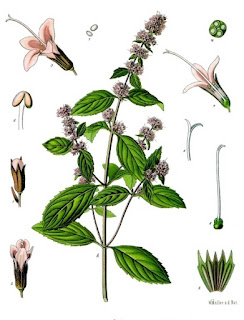- Get link
- Other Apps
- Get link
- Other Apps
It does not produce seeds that can germinate. The raw material in its case are shoots cut a few centimeters above the ground, about 30 centimeters high, with the beginnings of flower shoots. The leaves are dried at a temperature below 35 degrees Celsius. The finished dried herb should be stored in tightly closed containers, in a cool and dark place. By distillation, mint oil is obtained, and menthol can be obtained from the mint oil after freezing.
What can we find in mint?
The leaves contain at least 1.5% of essential oil, the ingredients of which are menthol, menthon, menthol esters and other compounds. As the mint blooms, the smell is getting worse. The oil is not the only medicinal component of the leaves - they also contain tannins, flavonoids, bitter compounds, phenolic acids and mineral salts.
What effect does mint have?
Mint stimulates the digestive system and liver. They improve digestion and the absorption of nutrients by the body. Mint has diastolic properties, reduces the tension of smooth muscles in the intestines, bile duct and urinary system. Mint leaves also have antibacterial effects thanks to the tannins and components of the essential oil. However, this action is short-lived, as the healing ingredients of mint do not accumulate in the body. Peppermint oil is most effective when we spray it in the air it has a bactericidal, cooling, analgesic and anti-inflammatory effect.
Menthol will have disinfecting effect. Everyone who has held it in their hands knows that it has a strong cooling effect on the skin. Peppermint oil can have side effects, so you should strictly follow the manufacturer's instructions.
When should we use mint?
Mint is probably the most popular herb in Poland. It is used very often in digestive disorders - for example, stomachache, flatulence, colic. Mint is beneficial for the liver and stimulates the secretion of bile. Mint has a weak calming effect, it is included in mixtures with just such an effect. In Septosan, mint supports the disinfecting effect on the mouth and throat. Peppermint oil has similar indications as the mint itself, along with menthol is included in toothpastes

Comments
Post a Comment